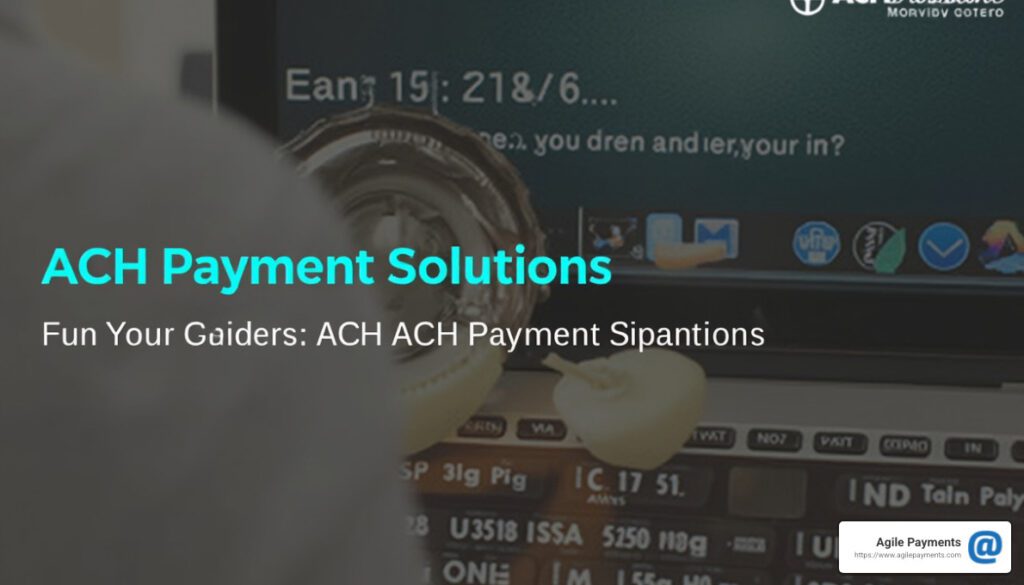ACH Payments: Top 5 Essential Facts You Need
ACH payment processing is a cornerstone of the modern financial system, facilitating the seamless transfer of funds between bank accounts across the United States. Governed by Nacha, the ACH Network orchestrates billions of transactions annually, offering a reliable and efficient method for electronic funds transfers.
Key Points:
- ACH payments move money electronically between U.S. bank accounts.
- Governed by Nacha, ensuring safe and effective transactions.
- Supports both consumer and business payments.
Imagine never needing to write a paper check again. This is the promise of the ACH Network, with its sophisticated and secure infrastructure managed by Nacha. It simplifies how businesses, governments, and individuals transfer funds, changing the landscape of electronic payments.
I’m Gene Krause, and with 25 years in the field of financial technologies, I bring a wealth of knowledge in ach payments systems. This foundation enables me to guide you through the intricacies of the ACH Network, satisfying your need for reliable, tech-savvy solutions.

What is an ACH Payment?
An ACH payment is a type of electronic transaction that allows money to move from one bank account to another. It’s part of the larger ACH payment system, which connects virtually every bank in the United States. This system makes everyday transactions more straightforward and efficient.
How It Works
The ACH payment system lets banks send and receive money electronically. This means no more checks to write or cash to handle. Instead, funds are transferred directly from one bank account to another. This is what we call a “bank-to-bank payment.”
Here’s a simple breakdown of the process:
- Initiation: A person or business starts a transaction, telling their bank to send money.
- Batch Processing: The bank gathers these requests and processes them in batches at specific times.
- Clearing and Settlement: The ACH operator (like the Federal Reserve) routes these transactions to the right banks.
- Completion: The receiving bank gets the funds and deposits them into the recipient’s account.
This process is governed by Nacha, ensuring transactions are secure and efficient. ACH payments can be used for many purposes, like paying bills, receiving paychecks, or transferring money to friends and family.
Benefits of ACH Payments
- Cost-Effective: ACH payments are usually cheaper than wire transfers or credit card transactions.
- Convenient: They eliminate the need for paper checks, reducing the hassle and risk of lost or stolen checks.
- Reliable: With billions of transactions processed annually, the ACH Network provides a dependable way to move money.
- Secure: Governed by strict rules and standards, ACH payments offer a high level of security.

The ACH payment system has become a vital part of how we handle money today. It’s a smart choice for anyone looking to streamline their financial transactions, whether for personal or business use.
How ACH Payments Work
When it comes to ACH payments, there are two main types: ACH Credit and ACH Debit. Understanding these helps in grasping how money moves through the system.
ACH Credit vs. ACH Debit
ACH Credit is like giving a gift. The person sending the money initiates the transaction. They “push” the money from their bank account to another person’s account. For example, when an employer deposits a salary directly into an employee’s bank account, it’s an ACH Credit.
On the flip side, ACH Debit is like pulling money from a source. Here, the recipient of the funds initiates the transaction. They “pull” the money from the sender’s account. A common example is when you set up automatic bill payments for utilities or subscriptions. With your permission, the company pulls the payment from your account each month.
Transaction Processing Time
ACH transactions are not instant. They typically take about 3 to 5 business days to complete. Here’s how it works:
- Day 1: The transaction is initiated. The bank collects these transactions and sends them in a batch to the ACH network.
- Day 2-3: The ACH operator processes the batch and sends it to the receiving banks.
- Day 4-5: The receiving bank processes the transaction and deposits the funds into the recipient’s account.
While most ACH payments follow this timeline, some are eligible for faster processing. Same-day ACH is available, but it usually comes with higher fees.

Security and Reliability
The reliability of ACH payments is backed by strict rules set by Nacha. These rules ensure that every transaction is secure. In fact, ACH payments have one of the lowest fraud rates among payment methods. This makes them a trusted choice for both businesses and individuals.
By using the ACH network, you benefit from cost savings, improved cash flow, and reduced manual work. It’s a seamless way to manage recurring payments, like subscriptions or payroll, without the hassle of manual intervention.
In summary, whether you’re sending money or receiving it, understanding how ACH Credit and ACH Debit work is key to making the most of this efficient payment system.
Benefits of ACH Payments
ACH payments offer several advantages that can make a big difference for businesses of all sizes. Let’s explore some key benefits: cost efficiency, improved cash flow, and automation.
Cost Efficiency
One of the standout features of ACH payments is their cost efficiency. Processing an ACH payment typically costs around $0.29 per transaction. This is significantly cheaper than credit card transactions, which often incur fees ranging from 1.3% to 3.5% of the transaction amount. Over time, these savings can add up, especially for businesses handling a large volume of transactions. By avoiding the high fees associated with credit cards and wire transfers, businesses can allocate more resources to other important areas.
Improved Cash Flow
ACH Debit gives businesses control over when they receive payments. By setting the transfer date, frequency, and amount, businesses can better manage their cash flow. This control helps ensure that funds arrive when needed, reducing the stress of chasing late payments. A steady cash flow is crucial for business planning and operations, allowing businesses to make informed decisions without the uncertainty of delayed payments.
Automation
Integrating ACH payments with existing accounting software can streamline financial processes. With the ability to set up recurring payments and automate transactions, businesses save time on manual administrative tasks like bank reconciliation. This automation frees up valuable time, letting businesses focus on growth and customer service instead of getting bogged down in paperwork.
Conclusion
By choosing ACH payments, businesses not only save money but also gain better control over their finances. The ability to automate payments further reduces administrative burdens, making ACH payments a smart choice for any business looking to optimize its payment processes.
Types of ACH Transactions
ACH transactions come in various forms, each serving a unique purpose. Let’s explore the main types: Direct Deposit, Direct Payment, and international payments.
Direct Deposit
Direct Deposit is a popular ACH transaction type used for transferring funds directly into a recipient’s bank account. It’s commonly used for payroll, where employees receive their salaries without needing a physical check. According to Nacha, this method is not only faster but also more secure than traditional paper checks. Employers save on printing and mailing costs, while employees enjoy the convenience of immediate access to their funds.
Direct Payment
Direct Payment is another crucial ACH transaction type. Unlike Direct Deposit, where money comes into your account, Direct Payment involves sending money out. This is often used for paying bills or making one-time or recurring payments. For businesses, this means they can collect payments from customers efficiently, reducing the risk of late or missed payments. Customers appreciate the ease of setting up automatic payments, which helps them avoid late fees and manage their budget better.
International Payments
While ACH payments are primarily used for domestic transactions, there are options for international payments as well. International ACH Transactions (IAT) allow for cross-border payments, but they are less common than domestic ACH transactions. Businesses dealing with international clients or suppliers may consider wire transfers or other methods for faster and more reliable international payments. It’s essential to note that ACH is mainly designed for transactions within the United States, and using it for international payments may involve additional steps and considerations.
In summary, understanding the different types of ACH transactions—Direct Deposit, Direct Payment, and international transactions—can help businesses and individuals choose the best method for their needs. Each type offers unique benefits, from cost savings to convenience, making ACH a versatile tool in electronic payments.
Frequently Asked Questions about ACH Payments
What does ACH payment mean?
ACH payment stands for Automated Clearing House payment. It’s a type of electronic funds transfer (EFT) that moves money between bank accounts through the ACH Network. This network is a secure system governed by Nacha, which connects banks and credit unions across the United States. ACH payments are a popular alternative to traditional checks, wire transfers, or cash, offering a reliable and cost-effective way to handle transactions.
How do I pay someone via ACH?
To pay someone using an ACH payment, you need a few key pieces of information:
- Bank account number: This is the account where the money will be sent.
- Routing number: This nine-digit number identifies the bank where the account is held.
- Account holder’s name: The name of the person or business receiving the payment.
- Payment amount: The sum of money you wish to transfer.
There are two main types of ACH payments:
ACH Credit: You initiate the transfer, pushing funds from your account to the recipient’s account. This is common for paying bills or sending money to friends and family.
ACH Debit: The recipient initiates the transfer, pulling funds from your account. This is often used for recurring payments, like monthly subscriptions or automatic bill payments.
Setting up an ACH payment is simple. Most banks and payment processors offer online portals where you can enter the required information and schedule payments.
Is ACH the same as routing?
No, ACH and routing are not the same. ACH refers to the network that processes electronic funds transfers between banks. In contrast, a routing number is a unique identifier for a bank within the ACH Network. Think of the routing number as the address of the bank, while the ACH Network is the postal service delivering the money. Together, they ensure that your payment reaches the right destination safely and efficiently.
Conclusion
As we’ve explored, ACH payments are a powerful tool for businesses and individuals alike. They offer a secure, cost-effective, and convenient way to manage transactions. At Agile Payments, we specialize in providing robust payment solutions that cater to the diverse needs of our clients. Our developer-friendly APIs make it easy to integrate ACH payments into your existing systems, streamlining your financial processes.
By choosing Agile Payments, you gain access to a suite of services designed to simplify electronic transactions, whether you’re operating in the U.S. or Canada. Our solutions are not just about processing payments; they’re about enhancing your overall payment strategy with flexibility and efficiency.
If you’re ready to take advantage of the benefits of ACH payments, consider exploring our ACH Payment Processing Providers page to learn more about how we can help you integrate and optimize your payment systems. Let’s work together to make your transactions smoother and more efficient.





